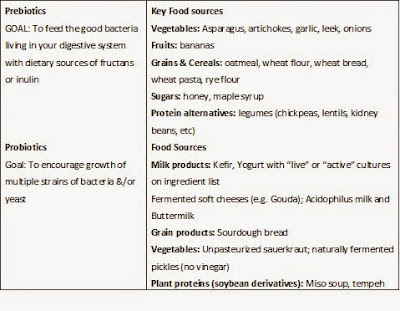Monday, October 27, 2014
Improve Your Endurance Performance with Pre and Probiotic Foods
Sunday, April 20, 2014
A Paleolithic Diet vs. Eating for Endurance
|
Food Origin |
PALEO DIET |
EAT for ENDURANCE |
|
Animal Foods |
INCLUDES: Lean meats (especially grass-fed animals) like
chicken, turkey, pork, lean beef, and buffalo Fish and seafood, eggs |
INCLUDES: Lean red meats, chicken, turkey, pork, etc Organ meats for iron Fish and seafood Eggs Milk, yogurt, cheese |
|
EXCLUDES: Milk, yogurt, cheese |
||
|
Plant Foods |
All nuts (except peanuts) and seeds |
All nuts and seeds |
|
Plant and nut-based oils (olive, walnut, grape seed,
and coconut) |
All plant, nut and seed based oils |
|
|
EXCLUDES: Seed oils (e.g. sunflower, safflower, etc) |
||
|
Fresh fruits |
FALL fresh, frozen and dried fruits 100% fruit juices |
|
|
ONLY non-starchy vegetables (broccoli, salad greens,
bell peppers, carrots, and squash) |
ALL starchy vegetables (e.g. potatoes, sweet
potatoes) and non-starchy vegetables Legumes (e.g. chickpeas, hummus, lentils, kidney
beans, etc) |
|
|
EXCLUDES: All grains & cereals, |
All grains & cereals (e.g. wheat, rice, quinoa,
oats, oatmeal, rye, barley, etc) |
|
|
Processing |
Only unprocessed foods without salt, refined sugars
and trans fats |
ONLY unprocessed and minimally processed foods Refined sugars during training (i.e. sport drinks
and gels) |
Saturday, March 22, 2014
Eat Wet Foods for Optimal Hydration and Body Weight – Year Round
|
Food Group |
REPLACE Dry Foods |
WITH Wet Foods |
|
Grains & Cereals |
Bread, toast, crackers, pita Granola bars, cereal, popcorn Muffins, cookies, biscuits Cake, donuts, pastries, pie |
Cooked oatmeal Cream of wheat Quinoa/rice/barley risotto Spaghettia, macaroni, fusilli |
|
Vegetables & Fruit |
Dried fruit Potato chips, vegetable chips Roasted veggies Baked fruit crumble Fruit pies |
Fresh veggies and fruit Steamed or stir fried veggies Vegetable and fruit salads Pureed fruits, fruit compote Fruit and vegetable smoothies Fruit yogurt |
|
Milk & Alternatives |
Brick cheeses Soft cheeses Shredded or grated cheeses |
Low fat/skim cottage cheese Quark cheese Tzatziki (cucumber and yogurt) Greek yogurt Low fat/skim milk, chocolate milk or flavoured yogurt Almond/soy milk |
|
Meat & alternatives |
Dried meats, sliced meats, roasted, grilled or barbecued meats Nuts and seeds, trail mix, nut butters Energy bars with soy protein |
Poached or steamed fish Meat/poultry stews Meat sauces More bean than meat chili Tofu stir fried with veggies Beef, barley, vegetable soup Hummus dip with raw veggies Three bean salads Lentil or tofu vegetable soup Black beans with quinoa and veggies |
Friday, March 14, 2014
Finding Your Sweet Spot
|
Type of Training
|
Carbohydrate Needs
|
Timing of Use |
Food & Fluid Options PER HOUR |
|
Easy intensity cardio or high intensity weights |
30 grams/hour
|
Split into two 30 minute intervals/hour |
· 500 mL sport drink (6% carbohydrate) · Water + granola bar or 6 graham crackers |
|
Moderate intensity, endurance training |
60 grams/hour |
Split into three 20 minute intervals/hour |
· Water + 2 sports gels · Water + 1 sports gel + 3 boiled potatoes · Water + 4 dates + 1 granola bar · 500 mL sport drink + 1 sports gel · 500 mL sports drink + granola bar |
|
Race pace, endurance training or competition (2-3+ hours) |
90 grams/hour |
Split into six 10 minute intervals/hour |
· Water + 3 sport gels · Water + 2 sports gels + 3 boiled potatoes · Water + 4 fig newtons + granola bar · 500 mL sports drink + 4 fig newtons + sport gel |


